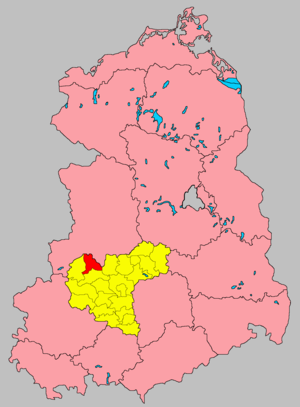Aschersleben district
| Basic data | |
|---|---|
| District of the GDR | Hall |
| County seat | Aschersleben |
| surface | 383 km² (1989) |
| Residents | 64,829 (1989) |
| Population density | 169 inhabitants / km² (1989) |
| License Plate | K and V (1953–1990) KB and VB (1974–1990) ASL (1991–1994) |
| The Aschersleben district in the Halle district (clickable map) |
|
The Aschersleben district ( ) was a district in the Halle district of the GDR . From 1990 to 1994 it existed as the Aschersleben district in the state of Saxony-Anhalt . His area is now in the Harz and Salzland districts in Saxony-Anhalt. The seat of the district administration was in Aschersleben .
geography
location
The district of Aschersleben was in the northeastern Harz foreland and was traversed by the Selke and the Wipper .
Communities
On June 30, 1994, immediately before its dissolution, the district consisted of the following 26 municipalities:
|
Neighboring areas
The district of Aschersleben bordered clockwise in the north, beginning with the districts of Staßfurt , Bernburg , Hettstedt , Quedlinburg , Halberstadt and Oschersleben .
history
On July 25, 1952, there was an extensive administrative reform in the GDR , during which, among other things, the states of the GDR lost their importance and new districts were established. The new Aschersleben district with its headquarters in Aschersleben was formed from parts of the former districts of Bernburg and Quedlinburg . The district was assigned to the newly formed Halle district .
On May 17, 1990, the district was renamed the Aschersleben district. On the occasion of the reunification of the two German states, the Aschersleben district was awarded to the re-established state of Saxony-Anhalt in October 1990 . During the first district reform in Saxony-Anhalt on July 1, 1994, it became part of the Aschersleben-Staßfurt and Quedlinburg districts .
Population development
| Aschersleben district | ||||||||
|---|---|---|---|---|---|---|---|---|
| year | 1960 | 1971 | 1981 | 1989 | ||||
| Residents | 76,692 | 73.506 | 67,672 | 64,829 | ||||
politics
District administrators
- 1990–1992: Walter Rothe
- 1992–1994: Thomas Leimbach
economy
Important companies included:
- VEB potash and rock salt operation "Saale" Aschersleben-Schierstedt
- VEB machine tool factory Aschersleben (WEMA)
- VEB body shop Aschersleben
- VEB Optima Aschersleben (packaging material)
- VEB conveyor equipment Aschersleben
- VEB geological drilling Aschersleben
- VEB Pipeline Construction Aschersleben
- VEB Geflügelwirtschaft Aschersleben
- VEB children's fashion Aschersleben
- VEB wool blanket factory Aschersleben
- VEB Leichtmetallwerk Nachterstedt
- VEB Rohrwerk Cochstedt
- VEB Baumaschinen Gatersleben
- VEB Tonfunk Ermsleben
traffic
The F 6 from Wernigerode via Aschersleben to Leipzig and the F 185 from Harzgerode via Aschersleben to Dessau were used for national road traffic.
The district with the routes Halle – Aschersleben – Halberstadt , Frose – Quedlinburg and Aschersleben – Köthen –Dessau was integrated into the railway network of the GDR .
License Plate
Motor vehicles (with the exception of motorcycles) and trailers were assigned three-letter distinctive signs starting with the letter pairs KB and VB from around 1974 to the end of 1990 . The last number plate series used for motorcycles was VF 00-01 to VF 99-99 .
At the beginning of 1991 the district received the distinguishing mark ASL .
Individual evidence
- ↑ a b Statistical Yearbooks of the German Democratic Republic. In: DigiZeitschriften. Retrieved October 6, 2009 .
- ↑ Area information. In: www.stala.sachsen-anhalt.de. Saxony-Anhalt State Statistical Office, accessed on May 3, 2015 .
- ↑ a b Federal Statistical Office (ed.): Municipalities 1994 and their changes since 01.01.1948 in the new federal states . Metzler-Poeschel, Stuttgart 1995, ISBN 3-8246-0321-7 .
- ↑ Law on the self-administration of municipalities and districts in the GDR (municipal constitution) of May 17, 1990
- ↑ Andreas Herzfeld: The history of the German license plate . 4th edition. German Flag Society V., Berlin 2010, ISBN 978-3-935131-11-7 , pp. 302 f .
- ↑ Andreas Herzfeld: The history of the German license plate . 4th edition. German Flag Society V., Berlin 2010, ISBN 978-3-935131-11-7 , pp. 519 .

